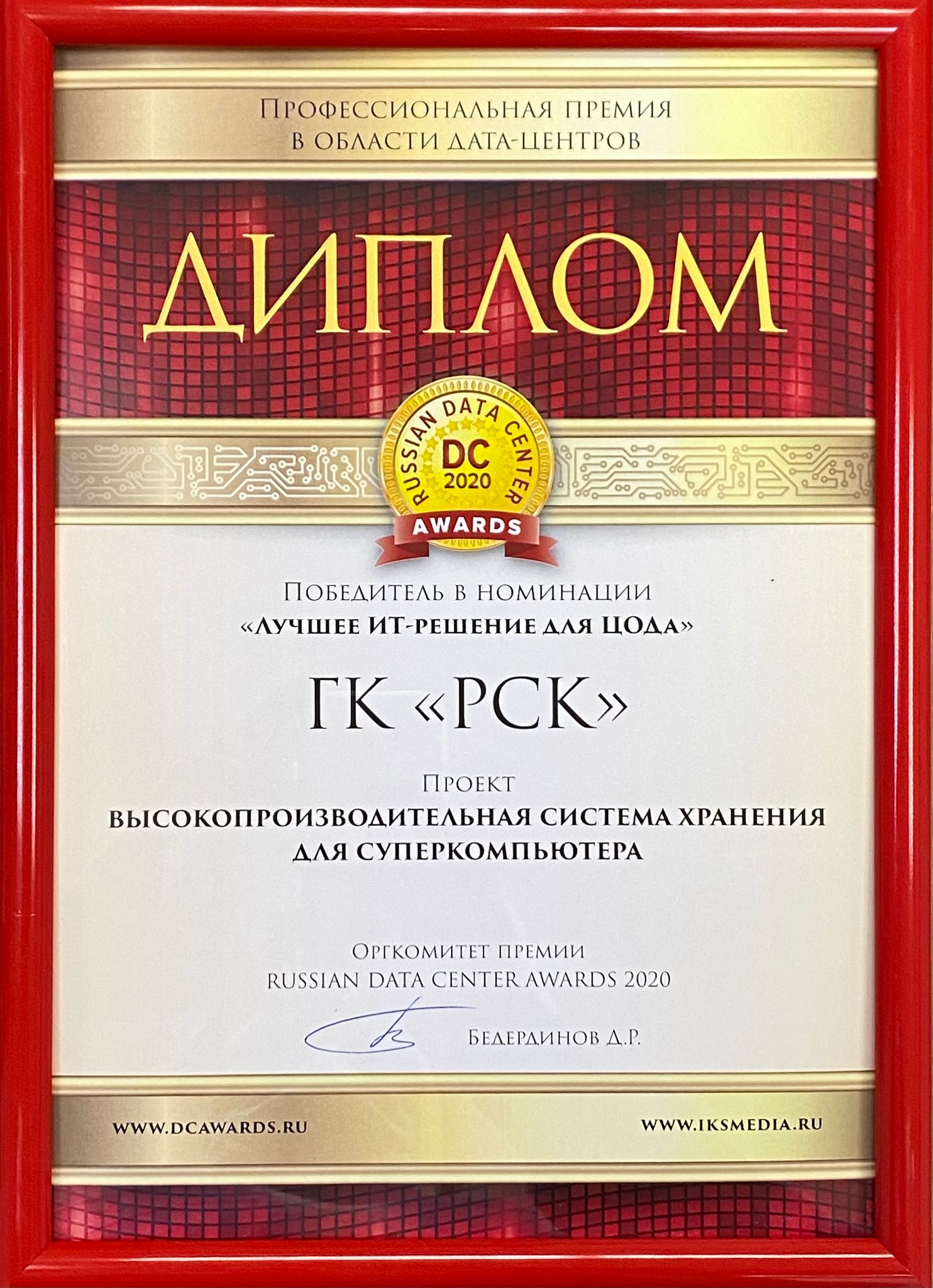Moscow, December 16, 2020 — RSC Group, the leading Russian developer and integrator of innovative, ultrahigh-dense and energy-efficient solutions for HPC (high-performance computing), data centers, cloud platforms and intelligent storage on-demand systems, has received Russian DC Awards 2020 in “The best IT solution for data centers” nomination at the award ceremony in Moscow hold on 10th December, 2020. Russian company won with its project “High-performance storage system for supercomputer” deployed this year at the Joint Institute for Nuclear Research (JINR) in Dubna, Moscow region.
“It's remarkable that RSC got this prestigious industry award almost at its 11th anniversary we celebrated on December 3rd, 2020. Since its foundation RSC Group has completed over 30 end-customer projects and registered 15 patents on inventions and utility models for its products and technologies not only in Russia, but also in Europe, USA, China and Japan,” – said Alexey Shmelev, Chief Operation Officer at RSC.
Unique high-speed storage system for Govorun supercomputer in JINR has leading characteristics, e.g. R/W speed of the parallel file system exceeds 300 GB/s, and it is based on RSC disaggregated composable storage architecture. This was achieved with RSC comprehensive hardware-software solutions as standard technologies with separate storage systems would involve much greater costs.
Unique implementation of “storage on-Demand” approach enables re-configuration of a specific storage system for each workload task with all required properties (capacity, speed, file system, persistence, reliability and security), which would be impossible to achieve with standard monolithic way to work with HPC storage.
RSC’s patented technology of cross-connection of network disks and N+M redundancy of storage servers ensures high reliability of the storage system.
Govorun supercomputer in JINR
World’s first hyper-converged 100% ‘hot water’ cooled Govorun supercomputer deployed at Joint Institute for Nuclear Research holds 22nd position in the new edition of global IO500 rating of the best performing HPC-level storage systems (as it was announced at SC20, the world’s largest supercomputer exhibition).
These excellent results were achieved due to unique distributed and composable RSC Storage on-Demand system. It is based on Intel® SSD and Intel® Optane SSD with NVMe interface. When Govorun supercomputer was commissioned and operational at JINR in June 2018, it occupied the high 9th place in the global IO500 rating. This system also has 11th position in local Top50 rating of the most powerful supercomputers in Russia and CIS region (September, 2020).
Govorun supercomputer of the Joint Institute for Nuclear Research is a joint project of the Theoretical Physics Laboratory (TPL) named after N.N. Bogolyubov and Laboratory of IT (LIT) supported by JINR board. It was deployed in 2018 with help of specialists from RSC Group and Intel Corporation.
The initial installation the Govorun supercomputer enabled to perform a lot of complex and resource-intensive simulations in the field of quantum chromodynamics patterns for research of hadronic matter properties at high energy density and barion charge and in presence of extra strong electromagnetic fields. It also accelerated generation and reconstruction of events for planned experiments for coming NICA ion collider. Supercomputer boosted calculation speed of radiation safety of experimental JINR units; significantly accelerated radiation biology research and other applied science problems at JINR; supported in international collaborations. Research results have been published in over 50 leading global science journals, including Nature Physics.
JINR supercomputer was upgraded twice in 2019-2020. The new hyper-converged and software-defined system has total theoretical peak performance of 860 TFLOPS with double precision. It’s novel approach has unique features to make it adaptable for specific user workloads and maximize utilization of supercomputer's resources.
The system has a number of different node types and allows unique flexibility of composable configurations:
• Base computing nodes — dual-socket nodes with two high speed NVMe drives based on Intel® Xeon® Scalable 2nd Generation processors (Intel® Xeon® Gold 8268), Intel® Server Board S2600BP and high-speed 2TB Intel® SSD DC P4511 drives with NVMe interface in M.2 form-factor, as well as one 100Gbps Intel® Omni-Path adapter. These nodes are the building blocks for standard computing and distributed storage-on-demand systems.
• Enhanced storage functionality nodes — base dual-socket nodes with 12 extra M.2 slots for high-speed NVMe disks and high-speed PCIe bus controllers supporting all advantages of modern storage technologies such as SDS, NVMe-over-Fabric, M.2 Hot Swap, etc. Nodes are based on Intel® Xeon® Scalable 2nd Generation processors (Intel® Xeon® Gold 8268), Intel® Server Board S2600BP, two 100Gbps Intel® Omni-Path adapters and:
• 12x high-speed Intel® SSD DC P4511 2TB M.2 drives with NVMe interface for high-speed static and storage-on-demand systems;
• or 12x high-speed low latency Intel® SSD DC Optane P4801X 375GB M.2 drives with NVMe interface.
These nodes can be used for high-capacity systems (up to 3.4TB per node) or as very fast parallel storage component (e.g. MDS in Lustre).
• Nodes for hyper-massive parallel tasks based on 72-core Intel® Xeon® Phi™ 7290 coprocessors, Intel® Server Board S7200AP, Intel® SSD DC S3520 M.2 drives with SATA interface.
Hyper-converged approach resulted in unique high-speed storage system for “Govorun” with leading characteristics and cost-efficiency.





